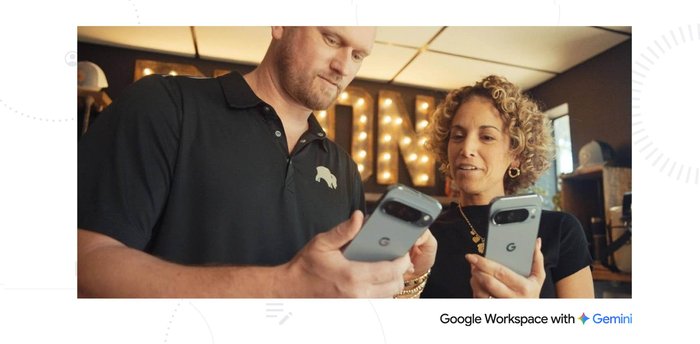Connecting 3,000 Grubhub users with Google Meet to boost collaboration, strengthen security, and reduce costs

Rick Paturzo
Senior Manager of Applications & Systems, Grubhub
Don Gibson
Senior Director of Employee Technology, Grubhub
Google Workspace Newsletter
Keep up with the evolving future of work and collaboration with insights, trends, and product news.
SIGN UPIn 2004, our co-founders Mike Evans and Matt Maloney were hungering for an alternative to thumbing through paper menus to find food. The solution was Grubhub, an online ordering platform that connects customers to local favorites. Twenty years later, the company has nearly 3,000 employees and contractors collaborating globally to innovate the way diners connect with restaurants.
We support our internal teams who make these connections possible. We make sure employees have access to the tools they need to do their jobs well, and when we evaluate tools, we always seek to understand what the end-user experience will look like. It’s also critical that we keep Grubhub’s customers and the company safe from any malicious activity without adding friction to workflows. Grubhub and our parent company, Just Eat Takeaway.com, have both used Google Workspace for years. Google Drive, Docs, Sheets, and Slides are all part of our day-to-day operations. Historically, we also had some teams already using Meet but we wanted to push adoption across the entire organization.
We knew that Workspace already met our administrative and user criteria. We also knew that the more we consolidate tools, the more we can improve the user experience and reduce how much we’re spending on additional software licenses.
Driving a smooth and empowering transition to Meet through education
Our team was challenged by executive leadership to migrate our video conferencing solution from a previous provider to Meet to lower software costs. Since Workspace was already so central to our operations, we knew these transitions would be straightforward, but we still set out to design a clear change management process and set expectations with all of our users.
A thorough understanding of the unique challenges of different departments at Grubhub was key to the success of the company-wide adoption of Meet. Our recruiting team, for example, had structured its processes around specific features of our previous video conferencing tool. To help the transition, we worked with our training and development team to produce a series of tips and tricks videos as well as documentation that helped employees learn to replicate the activities in Meet that they had relied on with the previous tool. This included tutorials on features such as screen sharing and using Meet’s progressive web app (PWA). Meet also has built-in tools to help troubleshoot issues, which was especially helpful for our service desk staff. All of these tools helped make the transition to Meet rather frictionless.
One challenge we had to overcome was shifting our company-wide town hall meetings and training calls to Meet. Since our organization has thousands of users, we couldn’t all fit into one Meet call. But with Meet’s live streaming capabilities, we found we could schedule the event and live-stream the call for all attendees. Our last town hall was successfully live-streamed to thousands of employees. After this company-wide process change, encouraging individual users to adopt Meet was much simpler.
Another feature of Meet that we believed eased our transition was its expansive library of fun reactions and visual effects. Google spent a lot of time creating interesting and quirky virtual backgrounds and filters, and our teams enjoy expressing their creativity and having fun in Meet. These features seem small, but they help make calls more engaging, and our teams feel more connected.
With so much executive and administrative support, we were able to ensure the transition went according to plan, phasing out additional conferencing and storage tools and saving thousands of dollars on those additional subscriptions. Adopting Meet also meant we were able to get rid of our old video conferencing app and all the maintenance that went with it.
Managing identity and security with a unified collaboration suite
With a unified collaboration and productivity suite, we've been able to benefit from Google Workspace's secure-by-design cloud infrastructure and powerful data controls for IT and security teams. The Google Admin console provides a central place for us to manage end-user access across all Workspace apps, including Gmail, Meet, and Drive. Being able to fine-tune role-based access control and permissions means we can safely share application access with only those who need it, easily review who is using which apps, and control who can access our files. And as easily as we’re able to grant access, our IT and security teams are able to quickly identify, triage, and respond to threats and revoke access to Workspace files in Drive just as quickly.
To further protect our data and our customers, we recently launched a major initiative to implement Workspace data loss prevention (DLP) rules to control the content users can share publicly. Our access control policies still enable us to safely share necessary resources with our drivers, restaurants, and partners. With the added security benefits of DLP features, Workspace is able to determine if documents contain sensitive information, such as social security or credit card numbers, and automatically apply data sensitivity labels. We’re alerted if that information is shared so we can take steps to protect that data and prevent unintended exposure.
Staying up to date with the future of work
Working with the Workspace team, we always have a clear way to make our voices feel heard. Submitting feedback and feature requests is simple, and our Workspace roadmap feels like a collaborative effort. We visit the Google Chicago office annually to meet with product leaders building new technologies, and it’s exciting to be a part of that growth. We’re constantly keeping up with new releases, which means we can also look forward to new ways of working as we keep our tech stack up to date.



